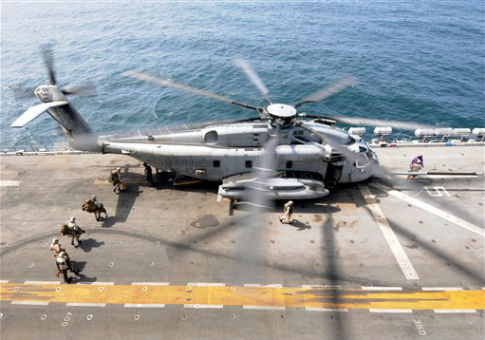The Pentagon's inspector general has launched an audit into the readiness of Marine Corps aviation units following an uptick in deadly crashes, including one blamed on pilot error and lack of training.
The Pentagon's assistant inspector general for readiness and cyber operations announced the audit in a memo last month, days before the Marines Corps publicly released an investigation into the January 14 helicopter crash off the coast of Oahu that killed a dozen Marines.
"We plan to begin the subject audit in October 2016. This is the second in a series of audits addressing military readiness," Carol Gorman, the assistant inspector general, wrote on October 17. "We will determine if United States Marine Corps aviation squadrons have sufficient fully mission capable aircraft and proficient pilots to meet minimum standards for their mission essential tasks. We will consider suggestions from management on additional or revised objectives."
"We will perform the audit at various United States Marine Corps and Naval aviation facilities and training centers," Gorman wrote. "We may identify additional locations during the audit."
The Marine investigation into the deadly January collision of two CH-53E Super Stallion helicopters conducting a nighttime flight concluded that the crash was caused by pilot error, a lack of training, and command problems.
Investigators found that the pilots of the aircraft had not met the Marine Corps' goals for flight hours in the 30 days leading up to the crash. They also discovered low confidence in executing basic tasks among pilots belonging to the Marine Heavy Helicopter Squadron 463 based at Kaneohe Bay, Hawaii as a result of insufficient training.
"In December 2015, copilots complained that during that year, although they were supposed to log 16 hours each month, they were lucky to log 10 hours," the investigation found. "By January 2016, many pilots in HMH-463 believed they were not ready for combat as they felt they would not be able to safely execute certain tasks, like safely landing a helicopter at night, because they were not logging enough flight training hours."
Lawmakers have pointed to the results of the investigation as evidence of the stress placed not only on the Marine Corps but all military services as a result of uncertain and declining defense funding.
"While this investigation reveals pilot error in the final seconds of this mission, it is clear that in the months, days, and hours beforehand, the Department failed these Marines," Rep. Mac Thornberry (R., Texas), chairman of the House Armed Services Committee, said in a statement last week. "I am particularly concerned by the readiness factors like maintenance and training that contributed to this fatal crash. Because of its size and structure, the stress on the Marine Corps is unmistakable. But, these readiness problems are strikingly similar to those faced by our Sailors, Soldiers, and Airmen each and every day."
"The Obama Administration's legacy will be framed by their decision to play political games with defense funding, rather than facing these problems head-on and working with Congress to fix them," Thornberry said. "These challenges were years in the making and will take years to correct. It is time to stop playing games and get to fixing these problems immediately."
The military services have been challenged to maintain readiness as they weather budget cuts, uncertainty, and force reductions. The military branches have reported consistently low readiness levels for years that officials expect to persist into the next decade, according to a Government Accountability Office report issued in September.
In testimony before the Senate Armed Services Committee this fall, four service leaders admitted that their forces would not be able to defend the homeland if sequestration continues.
Congress is in the process of negotiating defense spending and policy bills for fiscal 2017.
The inspector general memo was sent to Peter Levine, the acting undersecretary of defense for personnel and readiness, Marine commandant Robert Neller, and Vice Adm. Herman Shelanski, the Naval inspector general.
Marine deaths caused by aviation incidents were at a five-year high before the January crash in Hawaii. Thirteen separate incidents killed 18 Marines between May 2014 and September 2015, according to the Marine Corps Times.
The uptick in fatal helicopter crashes has led some lawmakers to question whether budget cuts have contributed to the incidents.
"I would say the CH-53 community is probably right now the most challenged because of a variety of reasons: available aircraft, certain maintenance issues that go back to a Navy MH-53 accident three years ago this past January," Neller told lawmakers on the Senate Appropriations defense subcommittee in March. "When you don't have enough airplanes to fly, then your flying hours go down and it becomes difficult to maintain your currency."
The Marine Corps did not respond to a request for comment on the audit.
